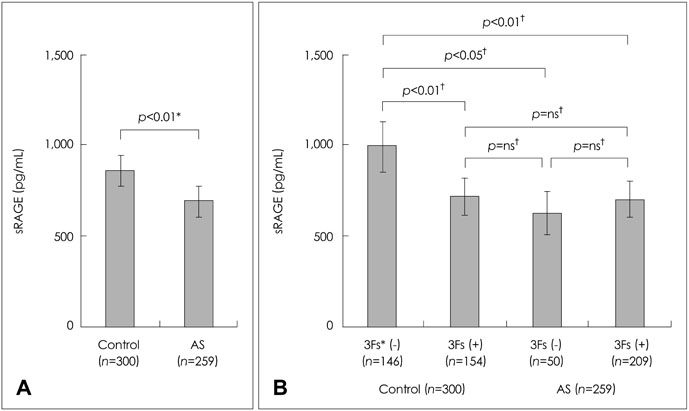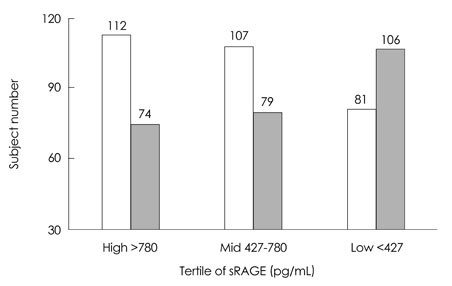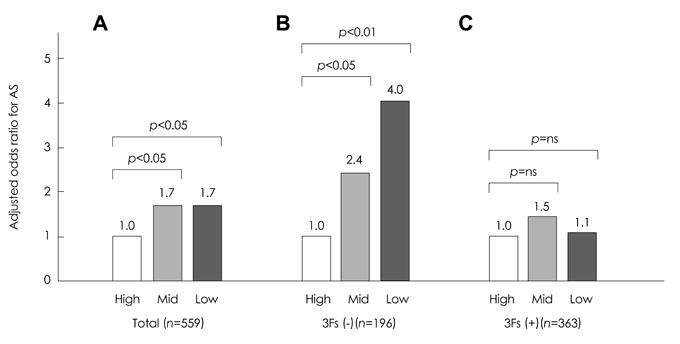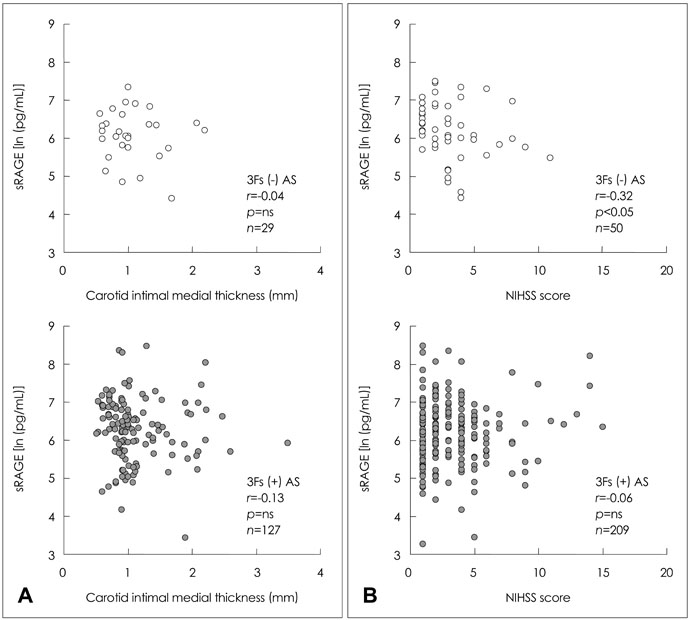J Clin Neurol.
2009 Sep;5(3):126-132. 10.3988/jcn.2009.5.3.126.
Levels of Soluble Receptor for Advanced Glycation End Products in Acute Ischemic Stroke without a Source of Cardioembolism
- Affiliations
-
- 1Department of Neurology, Wonkwang University School of Medicine, Iksan, Korea.
- 2Department of Cardiovascular Medicine, Wonkwang University School of Medicine, Iksan, Korea.
- 3Department of Laboratory Medicine, Wonkwang University School of Medicine, Iksan, Korea. email@wku.ac.kr
- 4Institute of Wonkwang Medical Science, Wonkwang University School of Medicine, Iksan, Korea.
- KMID: 2045418
- DOI: http://doi.org/10.3988/jcn.2009.5.3.126
Abstract
- BACKGROUND AND PURPOSE
Low levels of soluble receptor for advanced glycation end products (sRAGE) are associated with three conventional vascular risk factors (3Fs: diabetes, hypertension, and hypercholesterolemia), nondiabetic coronary artery disease, and Alzheimer's disease. However, the association between sRAGE and acute ischemic stroke (AS), especially AS without a source of cardioembolism, has not yet been established. Methods: Patients with AS without a source of cardioembolism (n=259) and age-matched controls (n=300) were grouped according to the presence of 3Fs: AS patients with and without 3Fs (3Fs+ AS and 3Fs- AS, respectively) and controls with and without 3Fs (3Fs+ control and 3Fs- control, respectively). Levels of sRAGE were analyzed among the four groups. RESULTS: sRAGE was significantly higher in the controls than in the AS patients (855 pg/mL vs. 690 pg/mL, p<0.01). sRAGE was significantly higher in 3Fs- controls (996 pg/mL, p<0.05) than in 3Fs+ controls (721 pg/mL), and in AS group regardless of the 3Fs (629 pg/mL in 3Fs- and 705 pg/mL in 3Fs+). The lowest tertile of sRAGE was associated with an increased risk of AS in the 3Fs- group [adjusted odds ratio (OR) 4.0, 95% confidence interval (CI) 1.6-10.3, p<0.01] but not in the 3Fs+ group. The level of sRAGE was also correlated with neurological severity in the 3Fs- AS group (r=-0.32, p<0.05) but not in the 3Fs+ AS group. CONCLUSIONS: Low plasma levels of sRAGE is a potential biomarker for the risk of AS and may reflect the neurological severity of the condition, especially in subjects without identifiable conventional risk factors.
Keyword
MeSH Terms
Figure
Reference
-
1. Brett J, Schmidt AM, Yan SD, Zou YS, Weidman E, Pinsky D, et al. Survey of the distribution of a newly characterized receptor for advanced glycation end products in tissues. Am J Pathol. 1993. 143:1699–1712.2. Hori O, Brett J, Slattery T, Cao R, Zhang J, Chen JX, et al. The receptor for advanced glycation end products (RAGE) is a cellular binding site for amphoterin. Mediation of neurite outgrowth and coexpression of rage and amphoterin in the developing nervous system. J Biol Chem. 1995. 270:25752–25761.
Article3. Stern D, Yan SD, Yan SF, Schmidt AM. Receptor for advanced glycation endproducts: a multiligand receptor magnifying cell stress in diverse pathologic settings. Adv Drug Deliv Rev. 2002. 54:1615–1625.
Article4. Basta G. Receptor for advanced glycation endproducts and atherosclerosis: from basic mechanisms to clinical implications. Atherosclerosis. 2008. 196:9–21.
Article5. Koyama H, Yamamoto H, Nishizawa Y. RAGE and soluble RAGE: potential therapeutic targets for cardiovascular diseases. Mol Med. 2007. 13:625–635.
Article6. Ma L, Carter RJ, Morton AJ, Nicholson LF. RAGE is expressed in pyramidal cells of the hippocampus following moderate hypoxic-ischemic brain injury in rats. Brain Res. 2003. 966:167–174.
Article7. Zhai DX, Kong QF, Xu WS, Bai SS, Peng HS, Zhao K, et al. RAGE expression is up-regulated in human cerebral ischemia and pMCAO rats. Neurosci Lett. 2008. 445:117–121.
Article8. Bucciarelli LG, Wendt T, Qu W, Lu Y, Lalla E, Rong LL, et al. RAGE blockade stabilizes established atherosclerosis in diabetic apolipoprotein E-null mice. Circulation. 2002. 106:2827–2835.
Article9. Basta G, Sironi AM, Lazzerini G, Del Turco S, Buzzigoli E, Casolaro A, et al. Circulating soluble receptor for advanced glycation end products is inversely associated with glycemic control and S100A12 protein. J Clin Endocrinol Metab. 2006. 91:4628–4634.
Article10. Geroldi D, Falcone C, Emanuele E, D'Angelo A, Calcagnino M, Buzzi MP, et al. Decreased plasma levels of soluble receptor for advanced glycation end-products in patients with essential hypertension. J Hypertens. 2005. 23:1725–1729.
Article11. Santilli F, Bucciarelli L, Noto D, Cefalù AB, Davì V, Ferrante E, et al. Decreased plasma soluble RAGE in patients with hypercholesterolemia: effects of statins. Free Radic Biol Med. 2007. 43:1255–1262.
Article12. Falcone C, Emanuele E, D'Angelo A, Buzzi MP, Belvito C, Cuccia M, et al. Plasma levels of soluble receptor for advanced glycation end products and coronary artery disease in nondiabetic men. Arterioscler Thromb Vasc Biol. 2005. 25:1032–1037.
Article13. Emanuele E, D'Angelo A, Tomaino C, Binetti G, Ghidoni R, Politi P, et al. Circulating levels of soluble receptor for advanced glycation end products in Alzheimer disease and vascular dementia. Arch Neurol. 2005. 62:1734–1736.
Article14. Adams HP Jr, Bendixen BH, Kappelle LJ, Biller J, Love BB, Gordon DL, et al. Classification of subtype of acute ischemic stroke. Definitions for use in a multicenter clinical trial. TOAST. Trial of Org 10172 in Acute Stroke Treatment. Stroke. 1993. 24:35–41.
Article15. Nakamura K, Yamagishi S, Adachi H, Kurita-Nakamura Y, Matsui T, Yoshida T, et al. Elevation of soluble form of receptor for advanced glycation end products (sRAGE) in diabetic subjects with coronary artery disease. Diabetes Metab Res Rev. 2007. 23:368–371.
Article16. Nakamura K, Yamagishi S, Nakamura Y, Takenaka K, Matsui T, Jinnouchi Y, et al. Telmisartan inhibits expression of a receptor for advanced glycation end products (RAGE) in angiotensin-II-exposed endothelial cells and decreases serum levels of soluble RAGE in patients with essential hypertension. Microvasc Res. 2005. 70:137–141.
Article17. Yamagishi S, Imaizumi T. Serum levels of soluble form of receptor for advanced glycation end products (sRAGE) may reflect tissue RAGE expression in diabetes. Arterioscler Thromb Vasc Biol. 2007. 27:e32. author reply e33-e34.
Article18. Koyama H, Shoji T, Yokoyama H, Motoyama K, Mori K, Fukumoto S, et al. Plasma level of endogenous secretory RAGE is associated with components of the metabolic syndrome and atherosclerosis. Arterioscler Thromb Vasc Biol. 2005. 25:2587–2593.
Article19. Katakami N, Matsuhisa M, Kaneto H, Matsuoka TA, Sakamoto K, Nakatani Y, et al. Decreased endogenous secretory advanced glycation end product receptor in type 1 diabetic patients: its possible association with diabetic vascular complications. Diabetes Care. 2005. 28:2716–2721.
Article20. Katakami N, Matsuhisa M, Kaneto H, Yamasaki Y. Serum endogenous secretory RAGE levels are inversely associated with carotid IMT in type 2 diabetic patients. Atherosclerosis. 2007. 190:22–23.
Article21. Katakami N, Matsuhisa M, Kaneto H, Matsuoka TA, Sakamoto K, Yasuda T, et al. Endogenous secretory RAGE but not soluble RAGE is associated with carotid atherosclerosis in type 1 diabetes patients. Diab Vasc Dis Res. 2008. 5:190–197.
Article22. Humpert PM, Djuric Z, Kopf S, Rudofsky G, Morcos M, Nawroth PP, et al. Soluble RAGE but not endogenous secretory RAGE is associated with albuminuria in patients with type 2 diabetes. Cardiovasc Diabetol. 2007. 6:9.
Article23. Jung KH, Roh JK. Circulating endothelial progenitor cells in cerebrovascular disease. J Clin Neurol. 2008. 4:139–147.
Article
- Full Text Links
- Actions
-
Cited
- CITED
-
- Close
- Share
- Similar articles
-
- The Role of Advanced Glycation End Products in Diabetic Vascular Complications
- Letter: The Association between Serum Endogenous Secretory Receptor for Advanced Glycation End Products and Vertebral Fractures in Type 2 Diabetes (Endocrinol Metab 2012;27:289-94, Cheol Ho Lee et al.)
- Effects of Angiotensin-Converting Enzyme Polymorphism on Soluble Receptor for Advanced Glycation End-Products in Maintenance Hemodialysis Patients
- Response: The Association between Serum Endogenous Secretory Receptor for Advanced Glycation End Products and Vertebral Fractures in Type 2 Diabetes (Endocrinol Metab 2012;27:289-94, Cheol Ho Lee et al.)
- Receptor for Advanced Glycation Endproducts (RAGE), Its Ligands, and Soluble RAGE: Potential Biomarkers for Diagnosis and Therapeutic Targets for Human Renal Diseases





